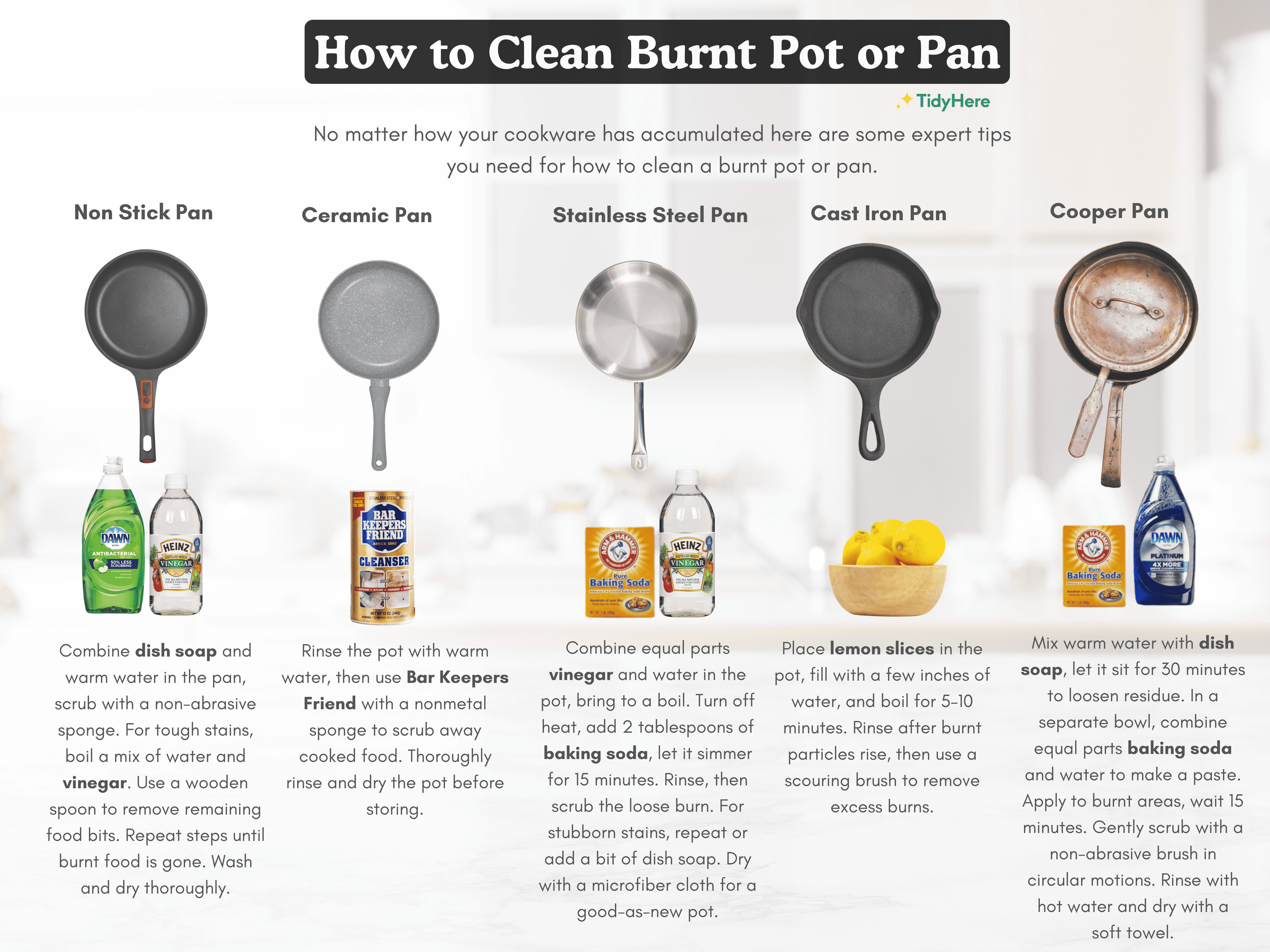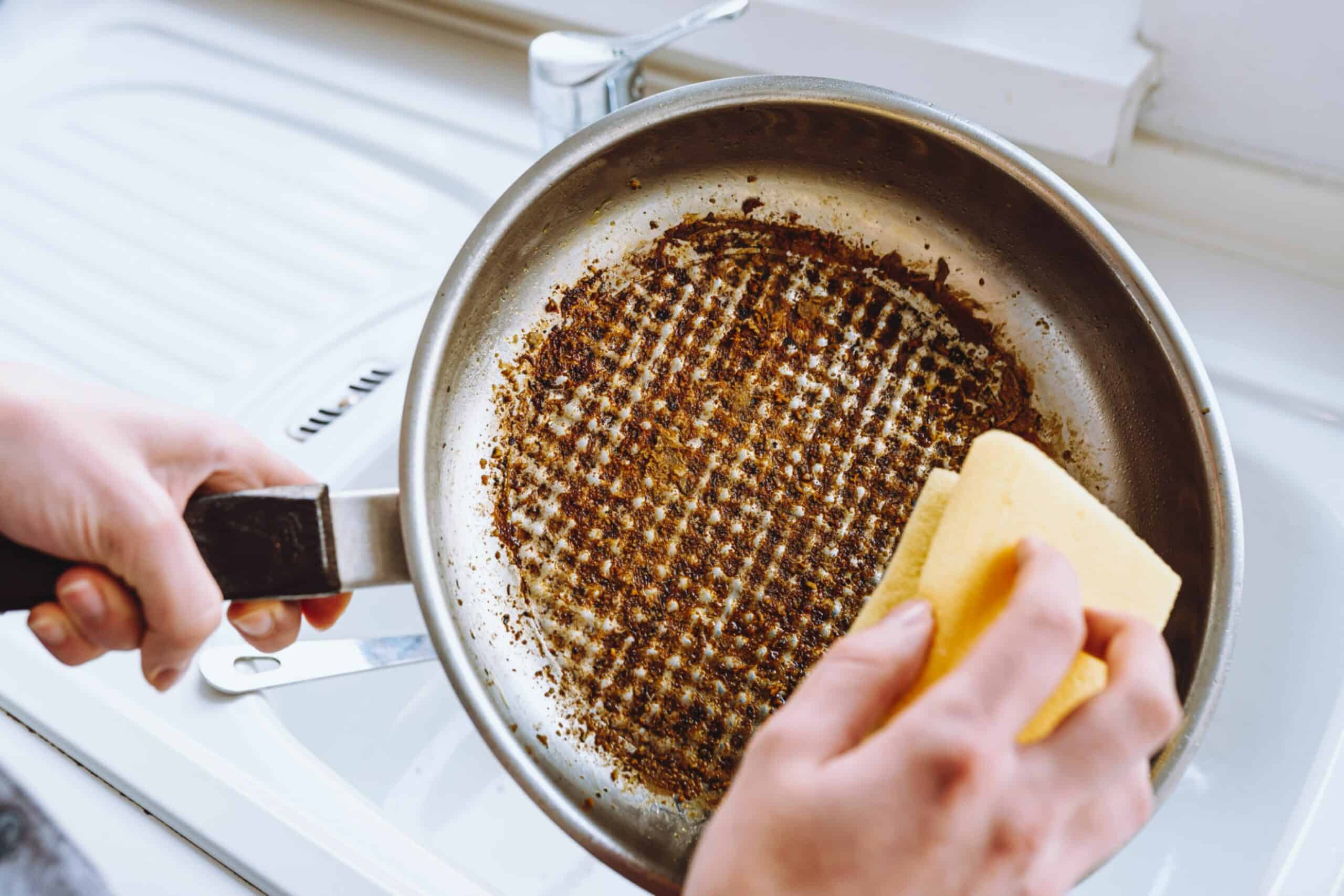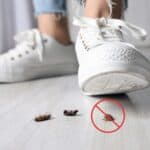Some recipes, or chefs, can end up wreaking havoc on our pots and pans. Of course, it can come down to user error, like when we set the burner too high and end up scorching whatever is in the pan. No matter what happened, or whose fault it may be, everyone has had to deal with burnt cookware at some point.
If you’re on the hunt for a simple, but effective method to rescue a burnt pot, we’ve got you covered. Much like with other popular cleaning hacks, lots of the items you need to restore your cookware are likely already in your pantry or among your cleaning supplies. Keep reading to find out more!
How to Clean a Burnt Pot or Pan
No matter how badly your cookware has been burnt, there may be a solution. Here are a few methods for cleaning a burnt pot or pan, whether it’s nonstick, ceramic, copper, cast iron, or stainless steel:
Baking Soda & Vinegar
White vinegar and baking soda are our favorite cleaning duo. You can use vinegar as a disinfectant, a non-toxic glass cleaner, and put it to use in the kitchen. Baking soda packs a lightly abrasive punch, so when the two are combined, they’re pretty effective. Here’s how you use them:
✨ Pour a small, equal amount of water and white vinegar around the bottom of the pot or pan.
✨ Heat this vinegar solution on your stovetop until it comes to a boil for about a minute.
✨ Once boiled, turn off the stove, remove the pot from heat, and pour out the vinegar.
✨ Pour a tablespoon or two of baking soda into the empty cookware and use a hard sponge or scouring pad to work the baking soda around the bottom of the pot or pan. Baking soda is abrasive and will help to lift the staining.
✨ Rinse the slurry of baking soda from the pot or pan and assess whether or not you’ll need to repeat the process or try another method.
Boiled Lemons
✨ Cut up two or three lemons, arrange them in your dirty pan, and fill it with enough water to just barely cover the lemons.
✨ Place the pan over medium-high heat and allow the lemon water to boil for 5 to 10 minutes.
✨ Remove the pan from the heat and scrub around the pan with a stiff brush or sponge when food particles start floating to the surface.
✨ Throw out the lemons and drain the water before rinsing the cookware with hot water.
✨ Use a scouring pad or brush to further loosen and remove any remaining residue.
Bar Keepers Friend
✨ Rinse your dirty pan under hot water, then make a paste with a few tablespoons of Bar Keepers Friend mixed with the residual water in the pan.
✨ Spread the paste around the burnt debris within your pan and leave this to sit for no more than a minute.
✨ After a minute, rinse the pan with hot water and then use a stiff brush or scouring pad to remove the now loosened burnt residue.
✨ You can repeat this process as needed or move on to a different method.
Aluminum Foil & Baking Soda
✨ Rinse the burnt pot in hot water, then sprinkle 2 generous tablespoons of baking soda, adding a few teaspoons of hot water to form a paste.
✨ Start to scrub the paste around the pan with a balled-up piece of aluminum foil until the burnt debris lifts.
✨ Once enough debris has been removed, rinse the pot again with hot water and a little bit of dish soap to finish.
Dishwasher Tablet
✨ Rinse the dirty pan with hot water and leave a very small amount of that water at the bottom of the cookware.
✨ Grab a dishwashing tablet and gently scrub the pan with the tab like you would with a sponge.
✨ Continue to scrub with the tablet until all the food debris lifts, or when the tablet fully dissolves, and finish by rinsing the cookware with hot water.
Dryer Sheet
✨ Soak the burnt pan with dish soap and hot water for about 10 minutes, then add a dryer sheet to the water.
✨ Allow this to sit for an hour so the dryer sheet can loosen the burnt-on food.
✨ After an hour, remove and throw away the dryer sheet, and rinse the cookware with hot water.
✨ You can repeat this as necessary, just be sure to fully rinse and wash out the pan with soap after each soak.
Other Ways to Clean Burnt Pan
We haven’t vetted these particular methods, but we know that some of them are go-to methods for many people! Feel free to give these a try and tell us how it goes:
Carbon Off
If you have cookie sheets, pots, pans, and or other cookware in need of rescue from burnt food messes, look out for a product called Carbon Off. It’s pretty powerful and similar to a paint stripper so if you use it, please remember to wear gloves!
Soda
While your burnt pan is still hot, pour in enough club soda or inexpensive store-brand soda to completely cover the bottom. Wait a few minutes to let the carbonation in the soda loosen the burnt grime, then wash the pan with soap and hot water.
Alka Seltzer
This medicine cabinet essential works similarly and just as well as club soda. Just add 1 or 2 tablets to the hot water covering the bottom of your pan, and leave it to work against stubborn burns like the soda method above.
Ketchup
Ketchup itself may not be acidic enough to remove burnt-on residue on pans, but it is great for bringing dull or tarnished cookware back to life. All you have to do is cover the area with a thin layer of ketchup, leave it for 10 to 15 minutes, and wipe it clean.
FAQs
Why does burnt food stick to the pan?
When food sticks to cookware it is generally caused by chemical bonds that form between the food and the material of the pan. To get chemical, these bonds are relatively weak covalent bonds that can be separated with a little effort.
How do I clean a burnt non-stick pan?
The best way to clean your non-stick pan is with baking soda and vinegar. Just mix 2 tablespoons each of white vinegar, baking soda, and water in your pan, heat it, and let the mixture boil for 5 minutes. After 5 minutes, let the pan cool and rinse it with hot water.
Is it safe to use a burnt nonstick pan?
Teflon, or non-stick, coatings on cookware start to break down at temperatures higher than 500 degrees. This releases toxic chemicals into the air and onto your food. Inhaling these fumes may lead to polymer fume fever, also known as the Teflon flu.
How do you get baked on grease off a pan?
Soak the pan with some dish soap and hot water to remove the food without too much elbow grease. This can save you time and effort, and also leave your pots and pans sparkling clean.
For more tips and tricks from your favorite team of Boston cleaning services, check out our blog full of cleaning guides and DIYs. If you’re looking for a little extra help around the house this holiday season, be sure to contact us and book your services today!
 Recurring Cleaning
Recurring Cleaning Move In / Out Cleaning
Move In / Out Cleaning Office Cleaning
Office Cleaning Housekeeping
Housekeeping Post Construction Cleaning
Post Construction Cleaning Green Cleaning
Green Cleaning Home Organization
Home Organization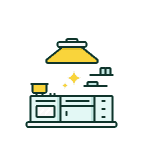 Deep Cleaning
Deep Cleaning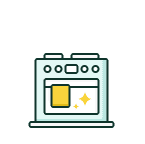 Oven Cleaning
Oven Cleaning Airbnb Cleaning
Airbnb Cleaning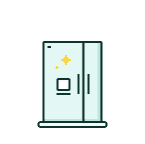 Refrigerator Cleaning
Refrigerator Cleaning
